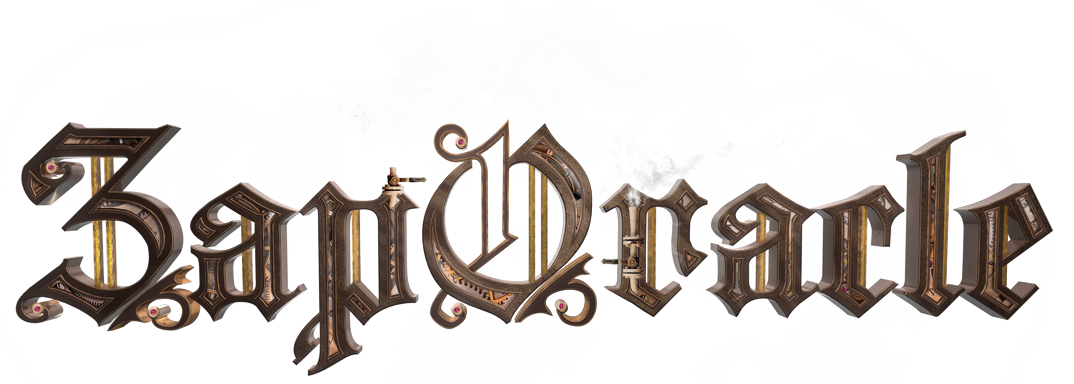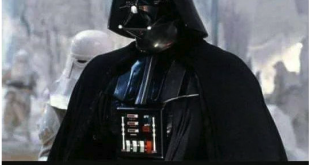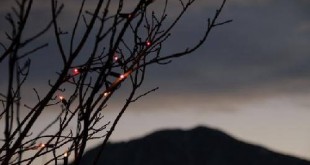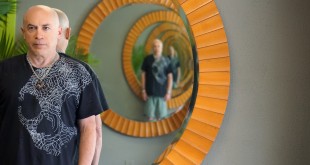
Untitled painting copyright Nathan Zap, 1977, oil on canvass
Best wishes for the solstice. A few quick news items before the main subject. If you use the Zap Oracle please note that finally every card has it’s own URL so you can link to them. Look for it in the image caption section.
I just put together a gallery of my dad’s paintings. He turns 93 in two days. I was astonished when I ran into a bunch of his paintings while doing some work at my parent’s house in the Bronx. They were full of symbols related to the Singularity Archetype. I point this out in the online gallery: Nocturnal Visions—Paintings by Nathan Zap
Speaking of 2012, I recently recorded a podcast of Vision at Chichén Itzá which is a kind of travelogue of my visit to Mayan ruins in Mexico with John Major Jenkins. And speaking of kind of travelogue, here’s a preview of the one I’m working on now:
ROUGH DRAFT, working title, photos and text copyright 2012, Jonathan Zap
Friday, June 16, 2012
As I was gathering my will to begin a journal of my summer odyssey, I was doing what so often precedes adventure these days—catching up on Facebook status updates. An Estonian semiotician I know, who only a few years ago was part of a tribe of young mutants from the state of Washington I first met in 2001 at a Rainbow Gathering, had just posted the following James Joyce reference:
Seccion Ameril: history is the nightmare
People, including me, quickly added comments:
Pär Tel: idiots+ideology 😉
Jonathan Zap: from which I am trying to awaken into the temporal evanescence, emotional disassociation and insubstantiality of facebook.
Seccion Ameril: doesn’t anyone know what day it is?
Jonathan Zap: Estonian Liberation Day, the day Estonia defeated Turkislamostan in 1166?
Matthew Serenissima Cristoforo Campanella: bloomsday
Pär Tel: It’s friday? 😀
Bloomsday, from Wikipedia:
“Bloomsday is a commemoration and celebration of the life of Irish writer James Joyce during which the events of his novel Ulysses (which is set on 16 June 1904) are relived. It is observed annually on 16 June in Dublin and elsewhere. Joyce chose the date as it was the date of his first outing with his wife-to-be, Nora Barnacle; they walked to the Dublin suburb of Ringsend. The name derives from Leopold Bloom, the protagonist of Ulysses.”
Leopold’s 24 hour odyssey is famous, not for any particularly dramatic occurrence, but for the approximately 265,000 words used to relate it. The words were also intentionally made to be difficult and full of obscure references.
According to Wikipedia:
“Joyce once said that he had ‘put in so many enigmas and puzzles that it will keep the professors busy for centuries arguing over what I meant,’ which would earn the novel ‘immortality.'”
If just one day in the life of an obscure Jew in turn-of-the-century Dublin was worth 265,000 tortured words, just think of how many mutated words could be applied to cover an entire summer’s travels of an obscure turn-of-the-millenium Jew currently residing in Boulder, Colorado? But to keep the word count from getting out of hand, I don’t plan to put myself under a Joycean free-associative linguistic microscope. For one thing, I long ago discovered the travel journal paradox—the more time you spend writing a travel journal in real time, the less there is to report about, unless you want to write about the journal writing process itself, which starts to become an infinite regress into solipsistic mirror worlds. Also, unlike Leopold Bloom, I’m much more concerned about my privacy, and if I were to reveal all the twists and turns of what’s going on in the obsessive depths of my personality, I would start to feel like an old Irish Jew getting a 265,000 word autopsy in public view. And so, to keep privacy and word count within decent limits, I’m going to lean toward keeping the camera pointed outward as much as possible. Of course, as a narcissistic introvert, even with the camera pointing outward, there will inevitably be lots of me talking behind the viewfinder relating almost everything back to myself.
These disclaimers, however, sound more self-indulgent than I intend. Whether the viewfinder is facing out, or in, I will be looking for things that may be of interest and use for the reader. I don’t plan to go gonzo on you. That approach is a ruling stereotype at this point. So much narrative journalism (see the movie Shattered Glass) is amped up, often through fabrication, as it contorts itself into the gonzo style.
I witnessed an example of this first hand several years ago. A Boulder Weekly writer went to a national Rainbow gathering and, like almost every journalistic report on it, went gonzo, trying to seem witty by exaggerating and caricaturing everything. Sure, there’s lots of stuff that’s all too ripe for that sort of treatment at Rainbow Gatherings, but there are also plenty of modest, sensible people doing practical work and good deeds who don’t get covered. (Since there will be much more about Rainbow Gatherings I recommend the excellent Wikipedia page: http://en.wikipedia.org/wiki/Rainbow_Gathering) The Boulder Weekly journalist described a talk given by a guy who “seemed like a cross between Charles Manson, Carl Sagan and Marshall McLuhan.” He was describing me, and a talk I gave on the singularity archetype. He quoted a number of absurd things I said. The problem was that I never said those things, and unbeknownst to him I was a Boulder resident (who would come to read his article) and had recorded the talk (I was in an audio journal phase). I called him up and told him I had a complete recording of the talk and that he had committed journalistic fraud. He didn’t try to deny anything. His voice was shaky and he offered to publicize any events I was doing in Boulder, etc. I could have ended his career, but he sounded young and I chose to give him another chance. Later, I realized that perhaps I shouldn’t have let him off so easy. Several years later, when I happened to run into Stuart Salo, the publisher of the Boulder Weekly, and told him about the episode, the journalist was long gone from the Weekly and I never pursued the matter.
Although there have been numerous high profile scandals in recent years about journalists and nonfiction writers fabricating their stories, we should keep in mind that these are just the extreme cases that get caught. The problem is probably pervasive. Since Gonzo style attracts narcissistic types, it is also a magnet for the attention-at-any-cost fabricator type. A recent example of the Gonzo-gone-wrong is Mike Daisy who did a one-man show about a visit he paid to Foxconn in China—the massive industrial facility where many Apple products are made. When NPR’s This American Life (a series I, and many, regard as a national treasure) gave a full show to the Mike Daisy account, it resulted in one of the most popular episodes of all time. A few weeks later, it spent an entire show publicly retracting the Mike Daisy episode when it learned that he had fabricated much of his story. (see http://www.thisamericanlife.org/radio-archives/episode/460/retraction)
The gonzo style was cool in its day because it was the extreme reaction to the ruling journalistic stereotype of yesteryear—the voice of a dignified, elder British gentleman looking at the world with elegant detachment and refined sensibility. In those days, it was as if we were seeing the world narrated by the host of Masterpiece Theater holding a pipe in one hand and a brandy snifter in the other.
I’m hoping to avoid both of those ruling stereotypes, but I also realize I’ve been deeply influenced by them, so don’t be surprised if elements of gonzo or the elder British gentleman creep in.
Pre Travel Excitement
I know it’s fashionable to narrate things from an ironic and cynical point of view (and I realize I’ve done my share of it), but the truth is that I am sincerely enthusiastic about almost any form of travel. I try to get to airports early because I love airports. To me they are magically liminal places filled with a vibe of international intrigue. And any airport you can think of has been the scene of international intrigue, and psychometrically they retain the aura of hidden dramas and the beginnings and endings of many odysseys.
But no, I’m not flying to any exotic locale, no attaché case will be hand-cuffed to my wrist, no war-torn countries or remote, uncharted wilderness will be visited. Right now my travel plans involve four American festivals. More about them later. To all of them I will be bringing my zaporacle.com ministry with me in the form of a “free dream interpretation” sign and a paper copy of my oracle.
When, just yesterday, I discovered that going to the national Rainbow Gathering was practicable, and I pulled the trigger on a plane ticket, I was so excited that when I did my daily canyon bike ride I had to listen to music since I was too distracted to listen to the more usual audiobooks. I also had some trouble getting to sleep last night, and stayed up and started sorting tradables I had put aside for my next Rainbow Gathering which I thought would be in 2013 instead of 2012.
The siren call of journeying intensifies when spring is about to turn to summer, and especially if there are travel plans about to actualize. This has been true for me since childhood when I counted down the days to summer camp. I’ve long noticed that, in the days before departure, things become heightened and weirder. The baseline reality seems scattered and becomes almost exotic. The all-too-familiar has a subtly unfamiliar edge. This zone, which I am in right now, is a liminal zone, a between-and-betwixt place, like an airport, and that which was a stable, encompassing, day-to-day reality is now a conditional, rapidly transitioning scenario/locale about to be replaced by new ones.
Since I am both imaginative and narcissistic, as travel approaches I become even more aware of myself as a character sojourning through a storyline. Awareness of myself as a householder living in a particular region recedes. The story is about to dramatically shift locales, but I’ll still be there. I seem to be the most constant presence in my own story, much more constant than places. Also, when you grow up in a place as specific and in-your-face as the Bronx, then you are forever impressed by the non-Bronxness of many subsequent places you may find yourself. The non-Bronx novelty of Boulder, for example, has never worn off.
Preparing for travel excites my Puer aeternus desire to continue being the adventuring star of my odyssey. In this way, traveling can be a highly self-referential endeavor. Perhaps this is what Emerson meant when he said that, “The problem with traveling is that you take yourself with you.” On the other hand, travel can be a secular pilgrimage and even an initiation—especially if there are intense misadventures, privations and soulful bonding with other travelers. Taking yourself with you is also part of the transformative potential of traveling. To actualize that potential, you have to be willing to allow travel to change you. Otherwise, traveling can devolve into stagnation with changing scenery.
Friday, June 16, 2012, afternoon
The self I took with me at about 1:30pm this afternoon was slightly agitated at how long it took me to get out of the house. I had a good writing session, but then seemed to keep finding one more thing to do while straightening up my home and getting ready to go out. Perhaps I was also more distractable due to the legal (thank you Colorado medical marijuanna) thc infused piece of chocolate I ate earlier in the morning. Since I use this substance very sparingly, it ramps up my intuition significantly and helped to inspire everything you’ve read in this journal so far. It can, however, increase my distractability when working on practical matters. (But to anyone out there who wants to diss this practice, please review the 2,000 words of complex, thoughtful sentences written under the influence, and see if you can equal that in the course of one morning of repressed sobriety.)
Once I stepped out of the house and unlocked my bike, I noticed something very relevant to travel. My mood had been greatly influenced by the people in the house. My closest friend Jason (a pseudonym, all names hereafter will be pseudonyms unless otherwise indicated) is also my housemate, and his two sons, Timmy and Scott, 4 and 7, were visiting. They are wonderful, charismatic boys whom I always delighted to see, but, appropriate to their age, they were going through rapid mood shifts and enacted little attention-getting dramas. As I biked, I realized that I had been influenced by their moods and the childish mood function of my psyche had been activated. I didn’t act on it, thankfully, but I felt it. As soon as I left the house the mood instability lifted and I was able to observe it.
This is an aspect of travel I need to bear in mind—I’m deeply affected (most of us are) by the human context I’m in. The immediate community of people forms an atmosphere of energy, a mini zeitgeist. This mini-zeitgeist is a phenomenon I find fascinating, and festivals are ideal situations in which to observe it. Rainbow and Burning Man, especially, have a compressed parabolic lifecycle, they intensify to a peak (July 4th Rainbow/burning the man/Burning Man) and then decline with shocking speed.
Of course, I contribute to all the atmospheres and mini-zeitgeists I participate in. A recent billboard in Los Angeles had the headline: “You’re not stuck in traffic. You are traffic.” For better or worse, I’m part of the social traffic, and I know that it’s a conceit to be a “detached observer” as if one were recording things from the inside of a space suit.
I was biking to the farmer’s market to get certain healthier treats to add to a birthday package for my dad who is turning 93 in a few days. I arrived just as all the vendors were breaking down. Apparently they get fined if they continue selling past the strict closing time of 2pm. Bouder, as a municipality, is known for its control freak tendencies. I can’t see any municipal advantage served by chasing them out. Why not let them stay into afternoon or evening if they want?
Fortuitiously, amongst the few vendors who had not broken down, was exactly the one I was looking for that had the confection I intended to get for my dad. I should also mention that about one minute before I got to this vendor I had put on my free dream interpretation sign. I had to overcome much reluctance to do this because downtown Boulder is often so full of false personality, and I felt like I was becoming a Boulder stereotype with the sign on while in the midst of people who really were Boulder stereotypes. For example, as I unlocked my bike, I noticed that in the most visible spot possible was a group of attractive thirty-something Boulderites ostentatiously doing acrobatic partner yoga. And then there was an extremely WASPish, tall boney man with white hair, khaki shorts and pale, boney legs that terminated in expensive loafers with no socks. He was an Aspen/Vail sort of a guy who looked like he had recently played golf with Mitt Romney’s corporate taxation lawyer. The sockless loafers, to my mind, were a vaguely anti-semitic affront to Boulder’s tarnished mutant heritage. They seemed to announce, “Yes, I am a WASP, and like Aspen or Vail, Boulder is one of my native lands, so I can walk its streets proudly attired in my native WASP casual attire.” And then there was the most ubiquitous of downtown Boulder stereotypes, the excercise-obssessed yuppie meticulously groomed to look exactly like they had just stepped out of the glossy pages of Men’s Health or Yoga Magazine.
When I do put on my dream interpretation sign (which is tastefully small) at the farmer’s market, it is rarely noticed, but still makes me feel self-conscious. I summoned my will to put it on out of commitment to the travel journal, and to the summer of carrying my zaporacle.com ministry out into the world, etc.
The people working the confection table were ones I hadn’t noticed before—a twenty-year-old young woman, and a sixteen year old boy and girl. The sixteen-year-old-girl seemed to be the most out-going, and was the one interacting with me as a salesperson when she halted, almost mid-sentence, and said, “Oh, wait, you do dream interpretation?” She had long dark hair, dramatically green eyes, and looked like the person you would cast as the younger heroine of a Jane Austin novel adapted for the present era (therefore I’ll call her “Rebecca”). Sixteen is the age identified by the I Ching as the time of life when acquired conditioning reaches its peak. Many sixteen-year-olds (I taught high school English for fourteen years so I feel qualified to make this observation) seem to be entirely made captive by conditioning, but Rebecca and the boy (whom we’ll call “Juan” since he had an hispanic name) did not seem like that at all, quite the opposite. They both seemed highly individuated and full of undamaged vitality and intelligence.
Rebecca continued, “I’ve been having intense lucid dreams recently—
(This is as far as I’ve gotten and have temporary run out of word-steam. The interupted episode above is very significant not only for the propitiousness of my dream interp vocation being so quickly summoned, but also for a lesson about timing. I felt down on myself for getting to the farmer’s market when it was breaking down, but actually it was the perfect moment. Not only was I still able to get what I wanted for my dad, but because it was breaking down, Rebecca and Juan had much more time to talk to me.)
 ZapOracle.com home to the free 720-card Zap Oracle
ZapOracle.com home to the free 720-card Zap Oracle






